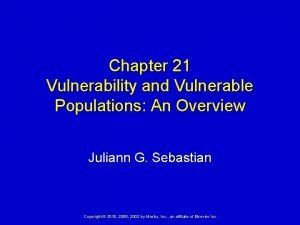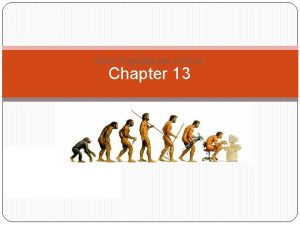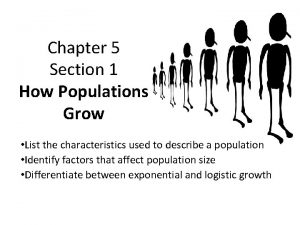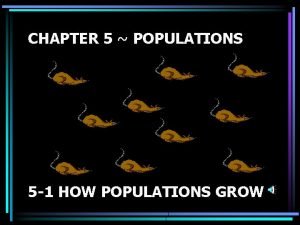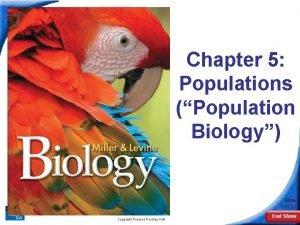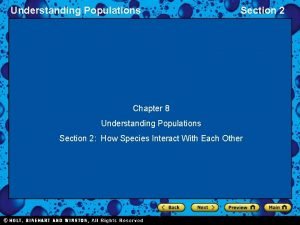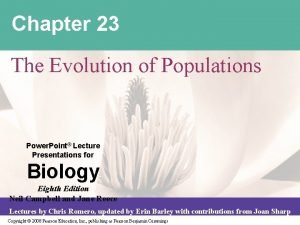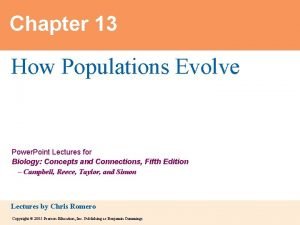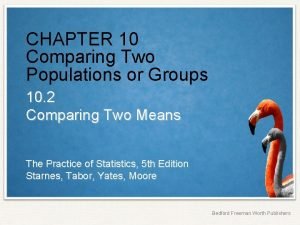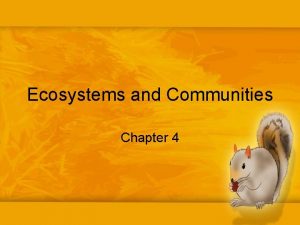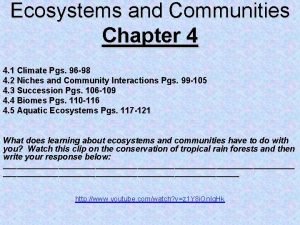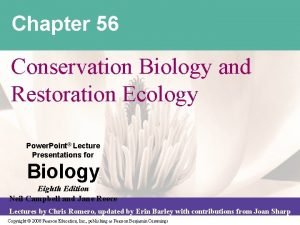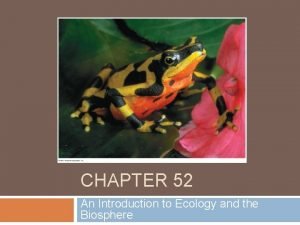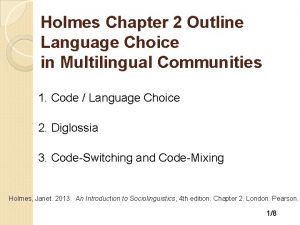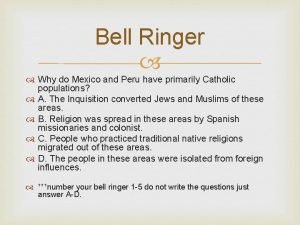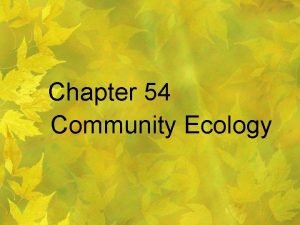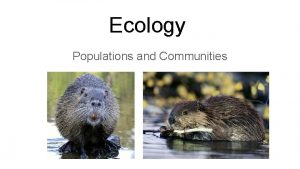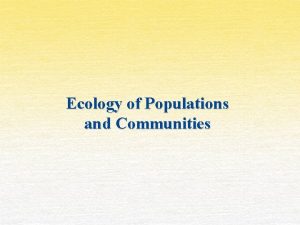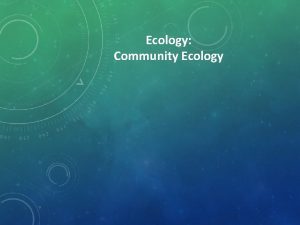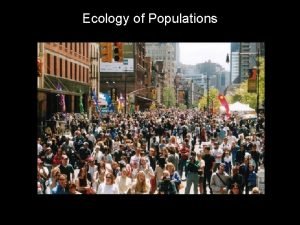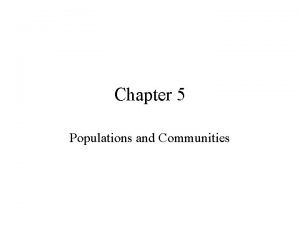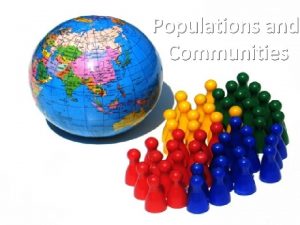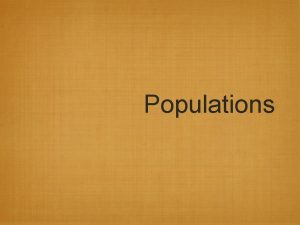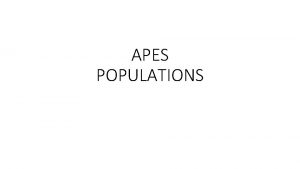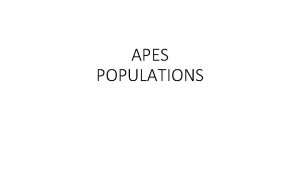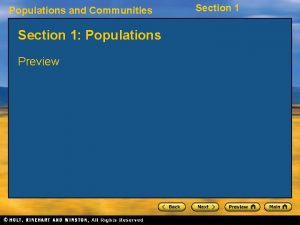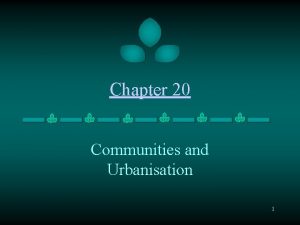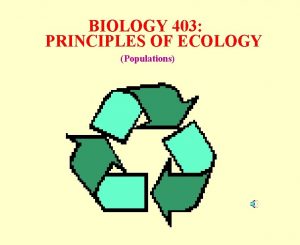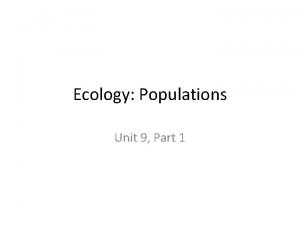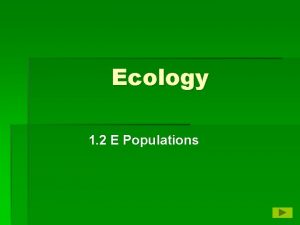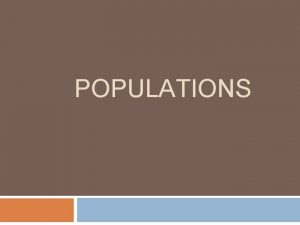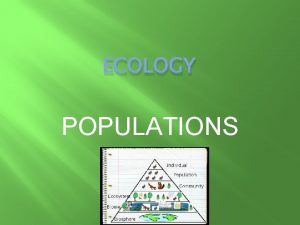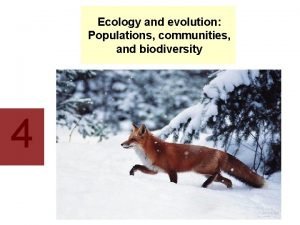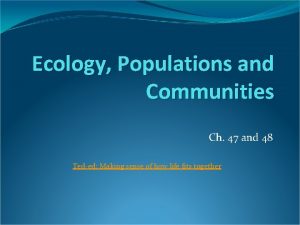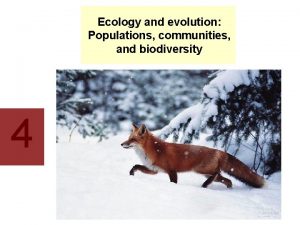Populations and Communities Chapter 1 Ecology and the































- Slides: 31

Populations and Communities Chapter 1 – Ecology and the Environment

Lesson 1 – Words to Know • • • Organism Habitat Biotic factor Abiotic factor Species Population Community Ecology Ecosystem

Living things and the Environment • An organism gets food, water, shelter and other things it needs to live, grow and reproduce from its environment. • AN environment that provides the things a specific organism needs to live grow and reproduce is called its HABITAT. • Are all parts of the forest where organisms live the same? How do they differ? • Why do you find different kinds of organisms in different habitats?

What are the Two Parts of an Organism’s Habitat? • An organism interacts with both the living and nonliving parts of its habitat • Biotic vs. Abiotic factors. • The parts of a habitat that are living or once living and interact with an organism are called biotic factors. • Not all the factor that organisms interact with are living. Abiotic factors are the nonliving parts of an organism’s habitat. • Soil, Temperature, oxygen and water.

Biotic vs. Abiotic Factors


How is an Ecosystem Organized? • Most organisms do not live all alone in their habitat. Instead, organisms live together in populations and communities that interact with abiotic factors in their ecosystems. • A species is a group of organisms that can mate with each other and produce offspring that can also mate and reproduce. • All the members of one species living in a particular area are referred to as a population. • A particular area contains more than one species of organisms. All DIFFERENT populations that live together in an area make a community.

Ecosystems • The smallest level of organization is a single organism, which belongs to a population that includes other members of its species. The population belongs to a community of different species. The community and abiotic factors together form a ecosystem. • The study of how organisms interact with each other and with their environment is called ECOLOGY.

Let’s Explore What are some living things in or near your home? What are some nonliving things in or near your home? What are the two kinds of factors in an organism’s environment? What factors cannot be seen? Using a park as an ecosystem, what is one squirrel considered to be? What is the name given to a group of squirrels living in the park? If you add the birds, butterflies, and ants to the park, what is the group of organisms called? • What is the smallest level of organization? • • •

Section 2 – Populations • Populations can change in size when new members join the population or when members leave the population. • The most common way in which new individuals join a population is be being born into it. • If more individuals are born into a population than die in any period of time, a population can grow. • Birth rate vs. death rate

Words to Know • • Birth Rate Death Rate Immigration Emigration Population Density Limiting Factor Carrying Capacity

The Population Statement • If the birth rate > death rate, population size increases. • If death rate > birth rate, population size decreases.

Immigration and Emigration • The size of a population also can change when individuals move into or out of the population. • Immigration means moving into a population, • Emigration means leaving a population. • What might cause an individual to immigrate? Why might individuals emigrate? • What is the effect of over-hunting?

Population Density • Sometimes an ecologist needs to know more than just the total size of a population. In many situations it is helpful to know the population density – the number of individuals in an area of specific size. • Population Density = Number of Individuals ____________ Unit Area

What Factors Limit Population Growth • Some limiting factors for populations are weather conditions, space, food and water. • A limiting factor is an environmental factor that causes a population to stop growing or decrease in size. • Climate – temperature, the amount of rainfall, floods, hurricanes, tornados, etc. • Space • Food and water – when food and water supplies are limited, organisms may leave. • The largest population that an area can support is called its carrying capacity.

Lesson 3 – Interactions Among Living Things Words to know • Natural Selection • Adaptation • Niche • Competition • Predator • Prey • Symbiosis • Mutualism • Commensalism • Parasitism • Parasite

Natural Selection • A characteristic that makes an individual better suited to a specific environment may eventually become common in that species through a process called natural selection. • Natural Selection – individuals with unique characteristics are wellsuited to an environment tend to survive and produce more offspring. Offspring that inherit these characteristics also live to reproduce. In this way adaptations are a result leading to physical characteristics to survive successfully. • Individuals with poorly suited characteristics are less likely to survive.

Niche • Every organism has a variety of adaptations that are suited to its specific living conditions and help it survive. • A niche includes what type of food the organism eats, how it obtains this food and what other organisms eat it.

What are competition and predation? • Two major types of interactions among organisms are competition and predation. • Different species can share the same habitat and food requirements. • The struggle between organisms to survive as they attempt to use the same limited resources is called competition. • An interaction in which one organism kills another food or nutrients is known as predation.

Competition vs. Predation

Predation • Predation can have a major affect on a prey population size. Generally, populations of predators and their prey rise and fall in related cycles. • Predator adaptations vs. prey adaptations.

What are the Three Types of Symbiosis • The three main types of symbiotic relationships are mutualism, commensalism, and parasitism

Mutualism • A relationship in which both species benefit is called mutualism.

Commensalism • Have you ever seen a bird build a nest in a tree? The bird gets a place to live while three is unharmed. This relationship is an example of commensalism.

Parasitism • Many family pets get treated with medication to prevent flea and tick bites. Without treatment, pets can suffer from severe health problems as a result of those bites. • A relationship th involves one organism living with, on, or inside another organism and harming it is called parasitism. • The organism that benefits is called the parasite. • The organism it lives on or in is called the host.

Let’s Review • Why might two individuals compete with each other? • Why might two organisms interact through predation? • How does natural selection result in adaptation being common in population? • What are adaptations?

Lesson 4 – Changes in Communities Words to Know • • Succession Primary Succession Pioneer Species Secondary Succession

Primary Succession • When a new island is formed by the eruption of an undersea volcano or an area of rock is uncovered by a melting sheet of ice, no living things are present. Overtime, living things will inhabit these areas. Primary Succession is the series of changes that occurs in an area where no soil or organisms exist. • Just like the pioneers that first settled new frontiers, the first species to populate an area are called pioneer species.

Primary Succession

Secondary Succession • Unlike Primary Succession, secondary succession occurs in a place where an ecosystem currently exists. • Secondary succession is the series of changes that occurs in an area where the ecosystem has been disturbed, but where soil and organisms still exist. • Natural disturbances that have this effect includes: fires, hurricanes, and tornadoes.

Secondary Succession
 Climax community in hydrarch succession comprises of
Climax community in hydrarch succession comprises of Chapter 21 vulnerability and vulnerable populations
Chapter 21 vulnerability and vulnerable populations Section 1 population dynamics answer key
Section 1 population dynamics answer key Chapter 16 evolution of populations vocabulary review
Chapter 16 evolution of populations vocabulary review Chapter 13 how populations evolve test
Chapter 13 how populations evolve test Chapter 17 evolution of populations answer key
Chapter 17 evolution of populations answer key 5-1 how populations grow
5-1 how populations grow 5-1 how populations grow
5-1 how populations grow Chapter 23: the evolution of populations
Chapter 23: the evolution of populations Chapter 16 evolution of populations
Chapter 16 evolution of populations Chapter 10 comparing two populations or groups crossword
Chapter 10 comparing two populations or groups crossword Chapter 5 lesson 1 how populations grow
Chapter 5 lesson 1 how populations grow Chapter 8 understanding populations
Chapter 8 understanding populations Chapter 23 the evolution of populations
Chapter 23 the evolution of populations Chapter 13 how populations evolve
Chapter 13 how populations evolve Chapter 10 comparing two populations or groups
Chapter 10 comparing two populations or groups Ecosystems and communities chapter 4 answer key
Ecosystems and communities chapter 4 answer key Chapter 4 ecosystems and communities
Chapter 4 ecosystems and communities Chapter 52 an introduction to ecology and the biosphere
Chapter 52 an introduction to ecology and the biosphere Chapter 56 conservation biology and restoration ecology
Chapter 56 conservation biology and restoration ecology Phosphorus cycle pearson education
Phosphorus cycle pearson education Chaparral climograph
Chaparral climograph Organism
Organism Chapter 55 ecosystems and restoration ecology
Chapter 55 ecosystems and restoration ecology Chapter 5 evolution and community ecology
Chapter 5 evolution and community ecology Chapter 5 evolution and community ecology answer key
Chapter 5 evolution and community ecology answer key Language choice in multilingual communities ppt
Language choice in multilingual communities ppt Stabilizing selection human birth weight
Stabilizing selection human birth weight Evolution of populations section 16-1 genes and variation
Evolution of populations section 16-1 genes and variation Why do mexico and peru have primarily catholic populations?
Why do mexico and peru have primarily catholic populations? Chapter 3 section 1: community ecology answer key
Chapter 3 section 1: community ecology answer key Chapter 54 community ecology
Chapter 54 community ecology

